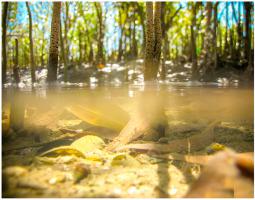Estuarine, Coastal and Shelf Science ( IF 2.6 ) Pub Date : 2021-04-03 , DOI: 10.1016/j.ecss.2021.107361 Isaac R. Santos , David J. Burdige , Tim C. Jennerjahn , Steven Bouillon , Alex Cabral , Oscar Serrano , Thomas Wernberg , Karen Filbee-Dexter , Julia A. Guimond , Joseph J. Tamborski

|
The term ‘Blue Carbon’ was coined about a decade ago to highlight the important carbon sequestration capacity of coastal vegetated ecosystems. The term has paved the way for the development of programs and policies that preserve and restore these threatened coastal ecosystems for climate change mitigation. Blue carbon research has focused on quantifying carbon stocks and burial rates in sediments or accumulating as biomass. This focus on habitat-bound carbon led us to losing sight of the mobile blue carbon fraction. Oceans, the largest active reservoir of carbon, have become somewhat of a blind spot. Multiple recent investigations have revealed high outwelling (i.e., lateral fluxes or horizontal exports) of dissolved inorganic (DIC) and organic (DOC) carbon, as well as particulate organic carbon (POC) from blue carbon habitats. In this paper, we conceptualize outwelling in mangrove, saltmarsh, seagrass and macroalgae ecosystems, diagnose key challenges preventing robust quantification, and pave the way for future work integrating mobile carbon in the blue carbon framework. Outwelling in mangroves and saltmarshes is usually dominated by DIC (mostly as bicarbonate), while POC seems to be the major carbon species exported from seagrass meadows and macroalgae forests. Carbon outwelling science is still in its infancy, and estimates remain limited spatially and temporally. Nevertheless, the existing datasets imply that carbon outwelling followed by ocean storage is relevant and may exceed local sediment burial as a long-term (>centuries) blue carbon sequestration mechanism. If this proves correct as more data emerge, ignoring carbon outwelling may underestimate the perceived sequestration capacity of blue carbon ecosystems.
中文翻译:

奥杜姆“蓝碳”科学中普遍存在的假说的复兴
“蓝色碳”一词是大约十年前创造的,用以强调沿海植被生态系统的重要固碳能力。该术语为制定计划和政策铺平了道路,这些计划和政策旨在保护和恢复这些受威胁的沿海生态系统,以缓解气候变化。蓝碳研究的重点是量化沉积物中的碳储量和掩埋率或作为生物质积累。对生境结合碳的关注使我们对流动的蓝色碳组分视而不见。海洋是最大的活性碳储集层,在某种程度上已经成为盲点。最近的多项调查表明,溶解的无机碳(DIC)和有机碳(DOC)以及来自蓝碳生境的颗粒有机碳(POC)的外排量较高(即,横向通量或水平出口)。在本文中,我们将红树林,盐沼,海草和大型藻类生态系统中的外围环境概念化,诊断阻止有效量化的关键挑战,并为将可移动碳整合到蓝色碳框架中的未来工作铺平道路。红树林和盐沼的外围地区通常以DIC(主要是碳酸氢盐)为主,而POC似乎是海草草甸和大型藻类森林出口的主要碳物种。碳外流科学仍处于起步阶段,估计仍在空间和时间上受到限制。然而,现有的数据集暗示碳外溢和随后的海洋存储是相关的,并且作为长期(>几个世纪)蓝色碳固存机制可能超过局部沉积物埋葬。如果随着更多数据的出现证明这是正确的,











































 京公网安备 11010802027423号
京公网安备 11010802027423号